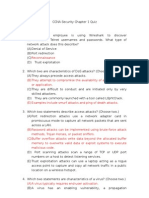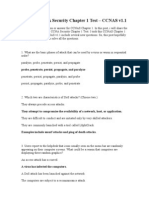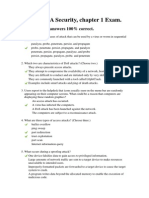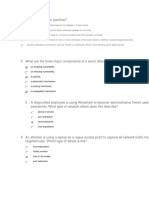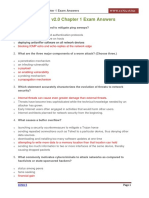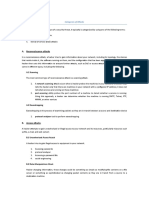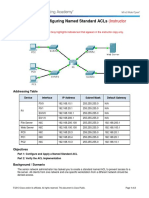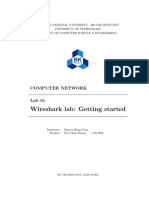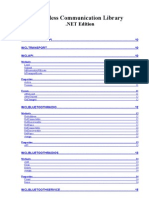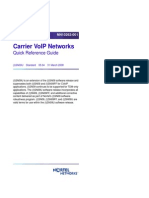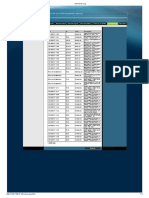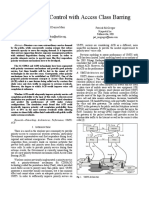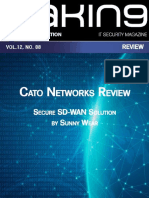Ccna Security Examen 1. 100%
Ccna Security Examen 1. 100%
Uploaded by
wamrojasCopyright:
Available Formats
Ccna Security Examen 1. 100%
Ccna Security Examen 1. 100%
Uploaded by
wamrojasCopyright
Available Formats
Share this document
Did you find this document useful?
Is this content inappropriate?
Copyright:
Available Formats
Ccna Security Examen 1. 100%
Ccna Security Examen 1. 100%
Uploaded by
wamrojasCopyright:
Available Formats
Cisco CCNA Security, chapter 1 Exam.
Questions and answers 100% correct.
1. What are the basic phases of attack that can be used by a virus or worm in sequential order? paralyze, probe, penetrate, persist, and propagate probe, penetrate, persist, propagate, and paralyze penetrate, persist, propagate, paralyze, and probe persist, propagate, paralyze, probe, and penetrate 2. Which two are characteristics of DoS attacks? (Choosetwo.) They always precede access attacks. They attempt to compromise the availability of a network, host, or application. They are difficult to conduct and are initiated only by very skilled attackers. They are commonly launched with a tool called L0phtCrack. Examples include smurf attacks and ping of death attacks. 3. Users report to the helpdesk that icons usually seen on the menu bar are randomly appearing on their computer screens. What could be a reason that computers are displaying these random graphics? An access attack has occurred. A virus has infected the computers. A DoS attack has been launched against the network. The computers are subject to a reconnaissance attack. 4. What are three types of access attacks? (Choosethree.) buffer overflow
ping sweep portredirection trust exploitation portscan Internet informationquery 5. What occurs during a spoofing attack? One device falsifies data to gain access to privileged information. Large amounts of network traffic are sent to a target device to make resources unavailable to intended users. Improperly formatted packets are forwarded to a target device to cause the target system to crash. A program writes data beyond the allocated memory to enable the execution of malicious code. 6. What is a characteristic of a Trojan Horse? A Trojan Horse can be carried in a virus or worm. A proxy Trojan Horse opens port 21 on the target system. An FTP Trojan Horse stops anti-virus programs or firewalls from functioning. A Trojan Horse can be hard to detect because it closes when the application that launched it closes. 7. Which phase of worm mitigation requires compartmentalization and segmentation of the network to slow down or stop the worm and prevent currently infected hosts from targeting and infecting other systems? containmentphase inoculationphase quarantinephase treatmentphase
8. Which two statements are characteristics of a virus? (Choosetwo.) A virus typically requires end-user activation. A virus has an enabling vulnerability, a propagation mechanism, and a payload. A virus replicates itself by independently exploiting vulnerabilities in networks. A virus provides the attacker with sensitive data, such as passwords. A virus can be dormant and then activate at a specific time or date. 9. What is a ping sweep? A ping sweep is a network scanning technique that indicates the live hosts in a range of IP addresses. A ping sweep is a software application that enables the capture of all network packets sent across a LAN. A ping sweep is a scanning technique that examines a range of TCP or UDP port numbers on a host to detect listening services. A ping sweep is a query and response protocol that identifies information about a domain, including the addresses assigned to that domain. 10. Which type of security threat can be described as software that attaches to another program to execute a specific unwanted function? virus worm proxy Trojanhorse Denial of Service Trojan horse 11. A disgruntled employee is using Wireshark to discover administrative Telnet usernames and passwords. Whattype of networkattackdoesthis describe? Denial of Service
portredirection reconnaissance trust exploitation 12. What occurs during the persist phase of a worm attack? identification of vulnerable targets modification of system files and registry settings to ensure that the attack code is running transfer of exploit code through an attack vector extension of the attack to vulnerable neighboring targets 13. What are the three major components of a worm attack? (Choosethree.) enablingvulnerability infectingvulnerability payload penetrationmechanism probingmechanism propagationmechanism 14. A network administrator detects unknown sessions involving port 21 on the network. Whatcould be causingthissecuritybreach? An FTP Trojan Horse is executing. A reconnaissance attack is occurring. A denial of service attack is occurring. Cisco Security Agent is testing the network. 15. What are three goals of a port scan attack? (Choosethree.) disable used ports and services
determine potentialvulnerabilities identify active services identifyperipheralconfigurations identifyoperatingsystems discoversystempasswords 16. How is a Smurf attack conducted? by sending a large number of packets, overflowing the allocated buffer memory of the target device by sending an echo request in an IP packet larger than the maximum packet size of 65,535 bytes by sending a large number of ICMP requests to directed broadcast addresses from a spoofed source address on the same network by sending a large number of TCP SYN packets to a target device from a spoofed source address 17. Which access attack method involves a software program attempting to discover a system password by using an electronic dictionary? buffer overflowattack portredirectionattack Denial of Serviceattack brute-forceattack IP spoofingattack packetsnifferattack 18 Which two network security solutions can be used to mitigate DoS attacks? (Choosetwo.) virus scanning data encryption
anti-spoofingtechnologies intrusionprotectionsystems applyinguserauthentication 19. Which phase of worm mitigation involves terminating the worm process, removing modified files or system settings that the worm introduced, and patching the vulnerability that the worm used to exploit the system? containment inoculation quarantine treatment 20. Which characteristic best describes the network security Compliance domain as specified by the ISO/IEC? the integration of security into applications an inventory and classification scheme for information assets the restriction of access rights to networks, systems, applications, functions, and data the process of ensuring conformance with security information policies, standards, and regulations 21. Which statement describes phone freaking? A hacker uses password-cracking programs to gain access to a computer via a dialup account. A hacker gains unauthorized access to networks via wireless access points. A hacker mimics a tone using a whistle to make free long-distance calls on an analog telephone network. A hacker uses a program that automatically scans telephone numbers within a local area, dialing each one in search of computers, bulletin board
systems, and fax machines. 22. Which two statements describe access attacks? (Choosetwo.) Port redirection attacks use a network adapter card in promiscuous mode to capture all network packets that are sent across a LAN. Password attacks can be implemented using brute-force attack methods, Trojan Horses, or packet sniffers. Buffer overflow attacks write data beyond the allocated buffer memory to overwrite valid data or exploit systems to execute malicious code. Port scanning attacks scan a range of TCP or UDP port numbers on a host to detect listening services. Trust exploitation attacks can use a laptop acting as a rogue access point to capture and copy all network traffic in a public location on a wireless hotspot.
You might also like
- Communication Networks Fundamental Concepts and Key Architectures 2nd Edition PDFDocument2 pagesCommunication Networks Fundamental Concepts and Key Architectures 2nd Edition PDFNicole0% (3)
- CEH: Certified Ethical Hacker v11 : Exam Cram Notes - First Edition - 2021From EverandCEH: Certified Ethical Hacker v11 : Exam Cram Notes - First Edition - 2021No ratings yet
- CCNA Security Ch01 Quiz AnswersDocument7 pagesCCNA Security Ch01 Quiz Answersdercole69No ratings yet
- Wireshark TCP v8.1Document9 pagesWireshark TCP v8.1vinayak457No ratings yet
- Cisco CCNA Security Chapter 1 Exam AnswersDocument5 pagesCisco CCNA Security Chapter 1 Exam Answersstu3232No ratings yet
- Chapter 1Document6 pagesChapter 1kramoxNo ratings yet
- Prueba Cap 1 CCNA SecurityDocument11 pagesPrueba Cap 1 CCNA SecurityGuillermo E Lobo PNo ratings yet
- Answer CCNA Security Chapter 1 Test - CCNAS v1.1: Probe, Penetrate, Persist, Propagate, and ParalyzeDocument10 pagesAnswer CCNA Security Chapter 1 Test - CCNAS v1.1: Probe, Penetrate, Persist, Propagate, and ParalyzeFranco SalernoNo ratings yet
- Cisco CCNA Security Module 1Document7 pagesCisco CCNA Security Module 1pollypolNo ratings yet
- CCNA Security Module 1 100%Document4 pagesCCNA Security Module 1 100%Akbal Larios100% (1)
- Cisco CCNA Security, Chapter 1 Exam. Cisco CCNA Security, Chapter 1 Exam. Cisco CCNA Security, Chapter 1 ExamDocument54 pagesCisco CCNA Security, Chapter 1 Exam. Cisco CCNA Security, Chapter 1 Exam. Cisco CCNA Security, Chapter 1 ExamAlexa JahenNo ratings yet
- Ccna SecurityDocument81 pagesCcna SecurityBrahim El-Asri100% (1)
- CCNA Security - Chapter 1 Exam AnswersDocument6 pagesCCNA Security - Chapter 1 Exam Answersrockynaruto0% (1)
- Cisco CCNA SecurityDocument85 pagesCisco CCNA SecurityPaoPound HomnualNo ratings yet
- CCNA Security Chapter 1 AssessmentDocument5 pagesCCNA Security Chapter 1 Assessmentp6aes2008100% (2)
- Capitulo 1 Ccna Security PDFDocument6 pagesCapitulo 1 Ccna Security PDFRafael RojasNo ratings yet
- CCNAS Chapter 1 CCNA Security 1Document10 pagesCCNAS Chapter 1 CCNA Security 1Sergiy KalmukNo ratings yet
- CCNA Security v2.0 Chapter 1 Exam AnswersDocument5 pagesCCNA Security v2.0 Chapter 1 Exam AnswersRussell FernandezNo ratings yet
- Cisco CCNA Security All ExamsDocument79 pagesCisco CCNA Security All ExamsLiuwal MuñozNo ratings yet
- Reconnaissance Scanning Gaining Access Maintaining Access Clearing TrackDocument11 pagesReconnaissance Scanning Gaining Access Maintaining Access Clearing TrackAlejo LomNo ratings yet
- CCNAS Module 1 100%Document6 pagesCCNAS Module 1 100%jagaBBNo ratings yet
- 13 17 AnswerDocument31 pages13 17 Answers2187022No ratings yet
- Categories of AttacksDocument4 pagesCategories of AttacksQais Saif QassimNo ratings yet
- Preguntas Tres Primeros Capitulos Netacad Prueba 1 CCNP3 en InglesDocument27 pagesPreguntas Tres Primeros Capitulos Netacad Prueba 1 CCNP3 en InglesPatricioNo ratings yet
- System Hacking and SniffingDocument8 pagesSystem Hacking and SniffingronakshefNo ratings yet
- TCP IP VulnerabilitiesDocument17 pagesTCP IP VulnerabilitiesHemant Sudhir Wavhal100% (1)
- Ccna S 2.0Document116 pagesCcna S 2.0loffy hackerNo ratings yet
- Final EndpointDocument11 pagesFinal Endpointoslervillamar06No ratings yet
- Ethical Hacking TrainingDocument31 pagesEthical Hacking TrainingKhoi DangNo ratings yet
- Habtamu ZelekeDocument9 pagesHabtamu Zelekeናዝራዊ አማኑኤል ጌታቸውNo ratings yet
- Networks and Network SecurityDocument10 pagesNetworks and Network SecurityashishNo ratings yet
- Network Security Ass CorrectionDocument26 pagesNetwork Security Ass CorrectionDUSABIMANA CYRIAQUENo ratings yet
- Ethical HackingDocument109 pagesEthical HackingRameswar ReddyNo ratings yet
- Exam CEHv10Document30 pagesExam CEHv10Benyhi Deyvi Mantilla FloresNo ratings yet
- Network Security AssignmentDocument4 pagesNetwork Security Assignmentbamie AhmedNo ratings yet
- Thinking Like A HackerDocument10 pagesThinking Like A HackerDharmsen SoniNo ratings yet
- Network SecurityDocument23 pagesNetwork SecurityNafisa AhmadNo ratings yet
- Organisational Systems Security: TOPIC 1: Potential Threats To ICT Systems and OrganizationDocument46 pagesOrganisational Systems Security: TOPIC 1: Potential Threats To ICT Systems and Organizationfate99No ratings yet
- Answers To Ethical Hacker Interview QuestionsDocument5 pagesAnswers To Ethical Hacker Interview Questionstsultim bhutiaNo ratings yet
- Source Code Analysis of Worms: Bapu0201@stcloudstate - Edu, Roar0301@stcloudstate - EduDocument12 pagesSource Code Analysis of Worms: Bapu0201@stcloudstate - Edu, Roar0301@stcloudstate - EduEmanuel DiegoNo ratings yet
- Ccna Sec 1.2 ExasDocument27 pagesCcna Sec 1.2 Exasesquirla300No ratings yet
- Módulos 16-17Document16 pagesMódulos 16-17gi.nunsysNo ratings yet
- Computer Security (Chapter-2)Document43 pagesComputer Security (Chapter-2)Naoly GetNo ratings yet
- Cyber Sec and Digital Forensics-Lec4Document34 pagesCyber Sec and Digital Forensics-Lec4persie parkerNo ratings yet
- Past CEH Preparation Sample QuestionsDocument18 pagesPast CEH Preparation Sample QuestionshamzahNo ratings yet
- Cyber Security 3Document16 pagesCyber Security 3Sooraj RajanNo ratings yet
- Penetration Testing Fundamentals -1: Penetration Testing Study Guide To Breaking Into SystemsFrom EverandPenetration Testing Fundamentals -1: Penetration Testing Study Guide To Breaking Into SystemsNo ratings yet
- Trusted Digital Circuits: Hardware Trojan Vulnerabilities, Prevention and DetectionFrom EverandTrusted Digital Circuits: Hardware Trojan Vulnerabilities, Prevention and DetectionNo ratings yet
- Common Windows, Linux and Web Server Systems Hacking TechniquesFrom EverandCommon Windows, Linux and Web Server Systems Hacking TechniquesNo ratings yet
- Wireless and Mobile Hacking and Sniffing TechniquesFrom EverandWireless and Mobile Hacking and Sniffing TechniquesNo ratings yet
- Cyberphobia: Identity, Trust, Security and the InternetFrom EverandCyberphobia: Identity, Trust, Security and the InternetRating: 3.5 out of 5 stars3.5/5 (9)
- The Art of Mac Malware, Volume 1: The Guide to Analyzing Malicious SoftwareFrom EverandThe Art of Mac Malware, Volume 1: The Guide to Analyzing Malicious SoftwareNo ratings yet
- Penetration Testing Fundamentals-2: Penetration Testing Study Guide To Breaking Into SystemsFrom EverandPenetration Testing Fundamentals-2: Penetration Testing Study Guide To Breaking Into SystemsNo ratings yet
- Certified Ethical Hacker (CEH) Preparation Guide: Lesson-Based Review of Ethical Hacking and Penetration TestingFrom EverandCertified Ethical Hacker (CEH) Preparation Guide: Lesson-Based Review of Ethical Hacking and Penetration TestingRating: 5 out of 5 stars5/5 (5)
- 9.2.1.11 Packet Tracer - Configuring Named Standard ACLs Instructions IG - Alexis PedrozaDocument10 pages9.2.1.11 Packet Tracer - Configuring Named Standard ACLs Instructions IG - Alexis Pedrozaalexis pedrozaNo ratings yet
- Connection LogDocument49 pagesConnection LogPaijo LondoNo ratings yet
- PassLeader 200-355 Exam Dumps (1-40)Document13 pagesPassLeader 200-355 Exam Dumps (1-40)Alex Morales BuenoNo ratings yet
- CiscoWorks LMS 3.2 Deployment Guide PDFDocument143 pagesCiscoWorks LMS 3.2 Deployment Guide PDFchindukNo ratings yet
- Sagittar SGT-LPN Manual Ver2.5Document92 pagesSagittar SGT-LPN Manual Ver2.5Ramiro MagnayonNo ratings yet
- Cisco Router Modes and Commands: User Exec ModeDocument1 pageCisco Router Modes and Commands: User Exec ModeGuillermo Ex TottiNo ratings yet
- ANCOM - En002 Testing VAMP Relay As Modbus SlaveDocument7 pagesANCOM - En002 Testing VAMP Relay As Modbus Slavethanhhiepvc2004No ratings yet
- 3G OPTI Crash CourseDocument13 pages3G OPTI Crash CourseoluwachintaNo ratings yet
- Wireless Access Networks Fixed Wireless Access and WLL Networks Design and OperationDocument425 pagesWireless Access Networks Fixed Wireless Access and WLL Networks Design and OperationJuan Dela Cruz0% (1)
- Blocking Internet Access While Allowing Local Area NetworkDocument4 pagesBlocking Internet Access While Allowing Local Area NetworkkumarchemNo ratings yet
- Architecture of An ISPDocument8 pagesArchitecture of An ISPSajad AliNo ratings yet
- Standard HuaweiDocument4 pagesStandard HuaweiPruebas Y aprendizajeNo ratings yet
- Command CiscoDocument16 pagesCommand CiscoBurhan RabbaniNo ratings yet
- Lab 1b Computer NetworkDocument4 pagesLab 1b Computer NetworkVăn Chấn DươngNo ratings yet
- QSG Fiber Access E2e GB 220902 A3Document9 pagesQSG Fiber Access E2e GB 220902 A3ideawifiNo ratings yet
- Huaweigpon PDFDocument1 pageHuaweigpon PDFRobNo ratings yet
- API ReferenceDocument73 pagesAPI ReferenceAnil JainNo ratings yet
- Carrier VoIP Networks Quick ReferenceDocument354 pagesCarrier VoIP Networks Quick Referencerio1603100% (1)
- Scan All 100Document49 pagesScan All 100Suman DasNo ratings yet
- Docsis Log Dpc3928sl2 Test Cpe 80b234cb0e18Document1 pageDocsis Log Dpc3928sl2 Test Cpe 80b234cb0e18Help PoligranNo ratings yet
- Session PlanDocument7 pagesSession PlannoeNo ratings yet
- Switch Fabric: Q1 Answer The Following Questions (11 Marks)Document3 pagesSwitch Fabric: Q1 Answer The Following Questions (11 Marks)ammad ahmadNo ratings yet
- UMTS Load Control With Access Class BarringDocument6 pagesUMTS Load Control With Access Class BarringTry TestNo ratings yet
- Review Cato NetworksDocument8 pagesReview Cato NetworksMiguel MurrietaNo ratings yet
- Remoute Maitenance Safari 17 DAR-8000Document178 pagesRemoute Maitenance Safari 17 DAR-8000drakonNo ratings yet
- Visiferm RS485 ProgrammersManual ODOUM102 11100430201Document97 pagesVisiferm RS485 ProgrammersManual ODOUM102 11100430201Saul FernandesNo ratings yet
- BPSK Vs QPSK in An AWGN ChannelDocument21 pagesBPSK Vs QPSK in An AWGN ChannelJaime FouchéNo ratings yet
- Wpa Migration Mode (Aircrack-Ng)Document4 pagesWpa Migration Mode (Aircrack-Ng)ombidasarNo ratings yet


